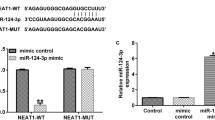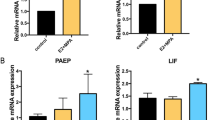Abstract
Background
Endometrial receptivity (ER), a pivotal event for successful embryo implantation, refers to the capacity of endometrium to allow the adhesion of the trophectoderm of the blastocyst to endometrial cells. In this paper, we set to elucidate whether the peptides encoded by lncRNAs could influence trophoblast cells’ adhesion to endometrial cells.
Methods
WGCNA construction and bioinformatics were used to find out the ER-related lncRNAs with coding potential. Protein analysis was done by immunoblotting and immunofluorescence (IF) microscopy. CCK-8 and Calcein-AM/PI double staining assays were employed to evaluate cell viability. The effect of the peptide on trophoblast spheroids’ adhesion to endometrial cells was evaluated. The RNA sequencing (RNA-seq) analysis was applied to identify downstream molecular processes.
Results
lncRNA LINC00339 was found to be related to ER development and it had been predicted to have protein-coding potential. LINC00339 had high occupancy of ribosomes and was confirmed to encode a 49-aa peptide (named LINC00339-205-49aa). LINC00339-205-49aa could promote the attachment of JAR trophoblast spheroids to Ishikawa endometrial cells in vitro. LINC00339-205-49aa also upregulated the expression of E-cadherin in Ishikawa cells. Mechanistically, MAPK and PI3K-Akt signaling pathways were involved in the modulation of LINC00339-205-49aa, which were activated by LINC00339-205-49aa in Ishikawa cells.
Conclusion
These data demonstrate that a previously uncharacterized peptide encoded by lncRNA LINC00339 has the ability to enhance JAR trophoblast spheroids’ adhesion to Ishikawa endometrial cells, highlighting a new opportunity for the development of drugs to improve ER.





Similar content being viewed by others
References
Ashary N, Tiwari A, Modi D. Embryo implantation: war in times of love. Endocrinology. 2018;159(2):1188–98.
Lessey BA, Young SL. What exactly is endometrial receptivity? Fertil Steril. 2019;111(4):611–7.
Neykova K, Tosto V, Giardina I, Tsibizova V, Vakrilov G. Endometrial receptivity and pregnancy outcome. The journal of maternal-fetal & neonatal medicine : the official journal of the European Association of Perinatal Medicine, the Federation of Asia and Oceania Perinatal Societies, the International Society of Perinatal Obstet. 2022;35(13):2591–605.
Baron C, Haouzi D, Gala A, Ferrieres-Hoa A, Vintejoux E, Brouillet S, Hamamah S. Endometrial receptivity in assisted reproductive techniques: an aspect to investigate in embryo implantation failure. Gynecologie, Obstetrique, Fertilite & Senologie. 2021;49(2):128–36.
Scott RT Jr. Endometrial receptivity screening in the general assisted reproductive technology population. Fertil Steril. 2021;115(4):895–6.
Bridges MC, Daulagala AC, Kourtidis A. LNCcation: lncRNA localization and function. J Cell Biol. 2021;220(2):e202009045.
Schmitz SU, Grote P, Herrmann BG. Mechanisms of long noncoding RNA function in development and disease. Cellular and molecular life sciences : CMLS. 2016;73(13):2491–509.
Aljubran F, Nothnick WB. Long non-coding RNAs in endometrial physiology and pathophysiology. Mol Cell Endocrinol. 2021;525:111190.
Zhang L, Yu Z, Qu Q, Li X, Lu X, Zhang H. Exosomal lncRNA HOTAIR promotes the progression and angiogenesis of endometriosis via the miR-761/HDAC1 axis and activation of STAT3-mediated inflammation. Int J Nanomedicine. 2022;17:1155–70.
Zhao H, Hu S, Qi J, Wang Y, Ding Y, Zhu Q, He Y, Lu Y, Yao Y, Wang S, et al. Increased expression of HOXA11-AS attenuates endometrial decidualization in recurrent implantation failure patients. Mol Therapy : J Am Soc Gene Ther. 2022;30(4):1706–20.
Feng C, Shen JM, Lv PP, Jin M, Wang LQ, Rao JP, Feng L. Construction of implantation failure related lncRNA-mRNA network and identification of lncRNA biomarkers for predicting endometrial receptivity. Int J Biol Sci. 2018;14(10):1361–77.
Wang Y, Hu S, Yao G, Zhu Q, He Y, Lu Y, Qi J, Xu R, Ding Y, Li J, et al. A novel molecule in human cyclic endometrium: lncRNA TUNAR is involved in embryo implantation. Front Physiol. 2020;11:587448.
Xing J, Liu H, Jiang W, Wang L. LncRNA-encoded peptide: functions and predicting methods. Front Oncol. 2020;10:622294.
Wu P, Mo Y, Peng M, Tang T, Zhong Y, Deng X, Xiong F, Guo C, Wu X, Li Y, et al. Emerging role of tumor-related functional peptides encoded by lncRNA and circRNA. Mol Cancer. 2020;19(1):22.
Cheng R, Li F, Zhang M, Xia X, Wu J, Gao X, Zhou H, Zhang Z, Huang N, Yang X, et al. A novel protein RASON encoded by a lncRNA controls oncogenic RAS signaling in KRAS mutant cancers. Cell Res. 2023;33(1):30–45.
Nelson BR, Makarewich CA, Anderson DM, Winders BR, Troupes CD, Wu F, Reese AL, McAnally JR, Chen X, Kavalali ET, et al. A peptide encoded by a transcript annotated as long noncoding RNA enhances SERCA activity in muscle. Science (New York, NY). 2016;351(6270):271–5.
Wu AH, Chen XL, Guo LY, Lu DF, Lu S, Wang AA, Liang XF. Downregulation of lncRNA IGF2-AS-encoded peptide induces trophoblast - cycle arrest. Reprod Biomed Online. 2021;43(4):598–606.
Zou Q, Du X, Zhou L, Yao D, Dong Y, Jin J. A short peptide encoded by long non-coding RNA small nucleolar RNA host gene 6 promotes cell migration and epithelial-mesenchymal transition by activating transforming growth factor-beta/SMAD signaling pathway in human endometrial cells. J Obstet Gynaecol Res. 2023;49(1):232–42.
Holdsworth-Carson SJ, Churchill M, Donoghue JF, Mortlock S, Fung JN, Sloggett C, Chung J, Cann L, Teh WT, Campbell KR, et al. Elucidating the role of long intergenic non-coding RNA 339 in human endometrium and endometriosis. Mol Hum Reprod. 2021;27(3):gaab010.
Powell JE, Fung JN, Shakhbazov K, Sapkota Y, Cloonan N, Hemani G, Hillman KM, Kaufmann S, Luong HT, Bowdler L, et al. Endometriosis risk alleles at 1p36.12 act through inverse regulation of CDC42 and LINC00339. Hum Mol Genet. 2016;25(22):5046–58.
Langfelder P, Horvath S. WGCNA: an R package for weighted correlation network analysis. BMC bioinformatics. 2008;9:559.
Nucera S, Giustacchini A, Boccalatte F, Calabria A, Fanciullo C, Plati T, Ranghetti A, Garcia-Manteiga J, Cittaro D, Benedicenti F, et al. miRNA-126 orchestrates an oncogenic program in B cell precursor acute lymphoblastic leukemia. Cancer Cell. 2016;29(6):905–21.
Akbar R, Ullah K, Rahman TU, Cheng Y, Pang HY, Jin LY, Wang QJ, Huang HF, Sheng JZ. miR-183-5p regulates uterine receptivity and enhances embryo implantation. J Mol Endocrinol. 2020;64(1):43–52.
Love MI, Huber W, Anders S. Moderated estimation of fold change and dispersion for RNA-seq data with DESeq2. Genome Biol. 2014;15(12):550.
Rahnama F, Thompson B, Steiner M, Shafiei F, Lobie PE, Mitchell MD. Epigenetic regulation of E-cadherin controls endometrial receptivity. Endocrinology. 2009;150(3):1466–72.
Bellati F, Costanzi F, De Marco MP, Cippitelli C, Stoppacciaro A, De Angelis C, Ruscito I, Rago R, Caserta D. Low endometrial beta-catenin and cadherins expression patterns are predictive for primary infertility and recurrent pregnancy loss. Gynecol Endocrinol the official J Int Soc Gynecol Endocrinol. 2019;35(8):727–31.
Li L, Jiang H, Wei X, Geng D, He M, Du H. Bu Shen Zhu Yun decoction improves endometrial receptivity via VEGFR-2-mediated angiogenesis. Evid -based Complement Alternative Med: eCAM. 2019;2019:3949824.
You F, Du X, Zhang T, Wang Y, Lv Y, Zeng L. TJZYF improves endometrial receptivity through regulating VEGF and PI3K/AKT signaling pathway. Biomed Res Int. 2022;2022:9212561.
Tóthová Z, Šemeláková M, Solárová Z, Tomc J, Debeljak N, Solár P. The role of PI3K/AKT and MAPK signaling pathways in erythropoietin signalization. Int J Mol Sci. 2021;22(14):7682.
Lee S, Rauch J, Kolch W. Targeting MAPK signaling in cancer: mechanisms of drug resistance and sensitivity. Int J Mol Sci. 2020;21(3):1102.
He M, Li L, Wei X, Geng D, Jiang H, Xiangxiang G, Zhang Y, Du H. Xiaoyao powder improves endometrial receptivity via VEGFR-2-mediated angiogenesis through the activation of the JNK and P38 signaling pathways. J Ethnopharmacol. 2022;282:114580.
Shen M, Liu Y, Ma X, Zhu Q: Erbu Zhuyu decoction improves endometrial angiogenesis via uterine natural killer cells and the PI3K/Akt/eNOS pathway a mouse model of embryo implantation dysfunction. American journal of reproductive immunology New York, NY : 2023 89(1):e13634.
Choi SW, Kim HW, Nam JW. The small peptide world in long noncoding RNAs. Brief Bioinform. 2019;20(5):1853–64.
Guo B, Wu S, Zhu X, Zhang L, Deng J, Li F, Wang Y, Zhang S, Wu R, Lu J, et al. Micropeptide CIP2A-BP encoded by LINC00665 inhibits triple-negative breast cancer progression. EMBO J. 2020;39(1):e102190.
Wang Y, Wu S, Zhu X, Zhang L, Deng J, Li F, Guo B, Zhang S, Wu R, Zhang Z, et al. LncRNA-encoded polypeptide ASRPS inhibits triple-negative breast cancer angiogenesis. J Exp Med. 2020;217(3):jem.20190950.
Chung TW, Park MJ, Kim HS, Choi HJ, Ha KT. Integrin αVβ3 and αVβ5 are required for leukemia inhibitory factor-mediated the adhesion of trophoblast cells to the endometrial cells. Biochem Biophys Res Commun. 2016;469(4):936–40.
Laheri S, Ashary N, Bhatt P, Modi D. Oviductal glycoprotein 1 (OVGP1) is expressed by endometrial epithelium that regulates receptivity and trophoblast adhesion. J Assist Reprod Genet. 2018;35(8):1419–29.
Sharma A, Mehan S. Targeting PI3K-AKT/mTOR signaling in the prevention of autism. Neurochem Int. 2021;147:105067.
Martínez-Limón A, Joaquin M, Caballero M, Posas F, de Nadal E. The p38 pathway: from biology to cancer therapy. Int J Mol Sci. 2020;21(6):1913.
Stefani C, Miricescu D, Stanescu S II, Nica RI, Greabu M, Totan AR, Jinga M. Growth factors, PI3K/AKT/mTOR and MAPK signaling pathways in colorectal cancer pathogenesis: where are we now? Int J Mol Sci. 2021;22(19):10260.
Huang H, Xia L, Xia Y, Yan Y, Jiang Z, Zhao P, Dong L. Tiaojing Cuyun Recipe enhances pregnancy outcome via the VEGF/PI3K/AKT/eNOS signaling pathway in EID mice. Dis Markers. 2022;2022:9461444.
Yu SL, Kang Y, Jeong DU, Lee DC, Jeon HJ, Kim TH, Lee SK, Han AR, Kang J, Park SR. The miR-182-5p/NDRG1 axis controls endometrial receptivity through the NF-κB/ZEB1/E-cadherin pathway. Int J Mol Sci. 2022;23(20):12303.
Bi Y, Huang W, Yuan L, Chen S, Liao S, Fu X, Liu B, Yang Y. HOXA10 improves endometrial receptivity by upregulating E-cadherin†. Biol Reprod. 2022;106(5):992–9.
Huang K, Chen G, Fan W, Hu L. miR-23a-3p increases endometrial receptivity via CUL3 during embryo implantation. J Mol Endocrinol. 2020;65(2):35–44.
Tiwari A, Ashary N, Singh N, Sharma S, Modi D. Modulation of E-cadherin and N-cadherin by ovarian steroids and embryonic stimuli. Tissue Cell. 2021;73:101670.
Jha RK, Titus S, Saxena D, Kumar PG, Laloraya M. Profiling of E-cadherin, beta-catenin and Ca(2+) in embryo-uterine interactions at implantation. FEBS Lett. 2006;580(24):5653–60.
Verma RK, Soni UK, Chadchan SB, Maurya VK, Soni M, Sarkar S, Pratap JV, Jha RK. miR-149-PARP-2 signaling regulates E-cadherin and N-cadherin expression in the murine model of endometrium receptivity. Reprod Sci (Thousand Oaks, Calif). 2022;29(3):975–92.
Funding
This work was supported by the Henan Province Crucial Research and Development and Promotion Projects (Tackling of Key Scientific and Technical Problems; Project number: 212102310048), the Henan Province Medical Science and Technology Research Program (Joint Co-construction; Project No.: LHGJ20210364), and the Doctoral Scientific Research Foundation of the Second Affiliated Hospital of Zhengzhou University (Project No.: 202104069).
Author information
Authors and Affiliations
Corresponding author
Ethics declarations
Conflict of interest
The authors declare no competing interests.
Additional information
Publisher’s note
Springer Nature remains neutral with regard to jurisdictional claims in published maps and institutional affiliations.
Highlights
1 LINC00339 can encode a 49-aa peptide.
2. LINC00339-205-49aa promotes JAR cells’ adhesion to Ishikawa cells.
3. MAPK and PI3K-Akt pathways are involved in the regulation of LINC00339-205-49aa.
Rights and permissions
Springer Nature or its licensor (e.g. a society or other partner) holds exclusive rights to this article under a publishing agreement with the author(s) or other rightsholder(s); author self-archiving of the accepted manuscript version of this article is solely governed by the terms of such publishing agreement and applicable law.
About this article
Cite this article
Zhou, B., Yu, G., Zhao, M. et al. The lncRNA LINC00339-encoded peptide promotes trophoblast adhesion to endometrial cells via MAPK and PI3K-Akt signaling pathways. J Assist Reprod Genet 41, 493–504 (2024). https://doi.org/10.1007/s10815-023-02995-6
Received:
Accepted:
Published:
Issue Date:
DOI: https://doi.org/10.1007/s10815-023-02995-6




